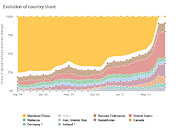Raevenlord
News Editor
- Joined
- Aug 12, 2016
- Messages
- 3,755 (1.23/day)
- Location
- Portugal
| System Name | The Ryzening |
|---|---|
| Processor | AMD Ryzen 9 5900X |
| Motherboard | MSI X570 MAG TOMAHAWK |
| Cooling | Lian Li Galahad 360mm AIO |
| Memory | 32 GB G.Skill Trident Z F4-3733 (4x 8 GB) |
| Video Card(s) | Gigabyte RTX 3070 Ti |
| Storage | Boot: Transcend MTE220S 2TB, Kintson A2000 1TB, Seagate Firewolf Pro 14 TB |
| Display(s) | Acer Nitro VG270UP (1440p 144 Hz IPS) |
| Case | Lian Li O11DX Dynamic White |
| Audio Device(s) | iFi Audio Zen DAC |
| Power Supply | Seasonic Focus+ 750 W |
| Mouse | Cooler Master Masterkeys Lite L |
| Keyboard | Cooler Master Masterkeys Lite L |
| Software | Windows 10 x64 |
The United States has now become the leading country in cryptocurrency mining operations, following China's mining ban and subsequent exodus of its mining operators to less dangerous waters. According to figures published by the Cambridge Centre for Alternative Finance, US-based miners reached a 35.4% share in overall bitcoin hashrate in July this year - up 17% compared to April, and only a month after China's move to ban all domestic cryptocurrency mining operations. In the months since, China's Bitcoin hash rate control declined from 44% in May of this year down to 0% as early as July - a far cry from its September 2019 high, which saw the country hold around 75% of the global mining hashrate.
As is usually the case, one country's loss equates to another's "gain", and the same is true for mining operations following the China ban. The US may have become the biggest player in this particular court, but any country with cheap electricity that allows for profits increases is fair game. Countries like Kazakhstan went from 8% to 18% in the same period, claiming the current second spot in overall hashrate, while Russia has now claimed third place after reaching an 11% share - rising from 6.8% three months earlier. It remains to be seen whether these mining operation relocations will see the US face the same migratory phenomenons as China did back when mining wasn't banned: operators spent the dry season on regions like Xinjiang in late autumn, winter and spring, migrating to regions with significant temporary overcapacities in low-cost hydropower, like Sichuan, between May and October during the 'wet season'. The impact of this mining relocation to the US in its power delivery infrastructure (if any) remains to be fully understood.


View at TechPowerUp Main Site
As is usually the case, one country's loss equates to another's "gain", and the same is true for mining operations following the China ban. The US may have become the biggest player in this particular court, but any country with cheap electricity that allows for profits increases is fair game. Countries like Kazakhstan went from 8% to 18% in the same period, claiming the current second spot in overall hashrate, while Russia has now claimed third place after reaching an 11% share - rising from 6.8% three months earlier. It remains to be seen whether these mining operation relocations will see the US face the same migratory phenomenons as China did back when mining wasn't banned: operators spent the dry season on regions like Xinjiang in late autumn, winter and spring, migrating to regions with significant temporary overcapacities in low-cost hydropower, like Sichuan, between May and October during the 'wet season'. The impact of this mining relocation to the US in its power delivery infrastructure (if any) remains to be fully understood.


View at TechPowerUp Main Site









